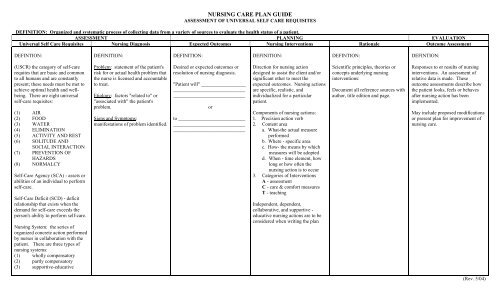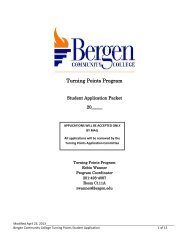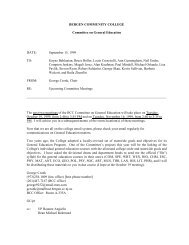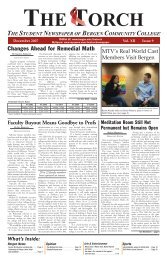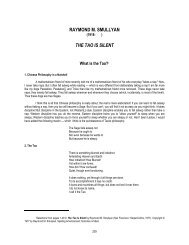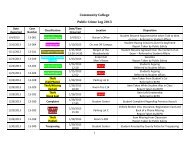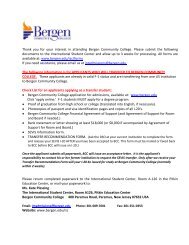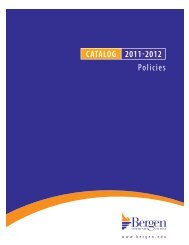Nursing Care Plan Guide - revised 5-04 - Bergen Community College
Nursing Care Plan Guide - revised 5-04 - Bergen Community College
Nursing Care Plan Guide - revised 5-04 - Bergen Community College
You also want an ePaper? Increase the reach of your titles
YUMPU automatically turns print PDFs into web optimized ePapers that Google loves.
NURSING CARE PLAN GUIDE<br />
ASSESSMENT OF UNIVERSAL SELF CARE REQUISITES<br />
DEFINITION: Organized and systematic process of collecting data from a variety of sources to evaluate the health status of a patient.<br />
ASSESSMENT PLANNING EVALUATION<br />
Universal Self <strong>Care</strong> Requisites <strong>Nursing</strong> Diagnosis Expected Outcomes <strong>Nursing</strong> Interventions Rationale Outcome Assessment<br />
DEFINTION:<br />
(USCR) the category of self-care<br />
requites that are basic and common<br />
to all humans and are constantly<br />
present; these needs must be met to<br />
achieve optimal health and wellbeing.<br />
There are eight universal<br />
self-care requisites:<br />
(1) AIR<br />
(2) FOOD<br />
(3) WATER<br />
(4) ELIMINATION<br />
(5) ACTIVITY AND REST<br />
(6) SOLITUDE AND<br />
SOCIAL INTERACTION<br />
(7) PREVENTION OF<br />
HAZARDS<br />
(8) NORMALCY<br />
Self-<strong>Care</strong> Agency (SCA) - assets or<br />
abilities of an individual to perform<br />
self-care.<br />
Self-<strong>Care</strong> Deficit (SCD) - deficit<br />
relationship that exists when the<br />
demand for self-care exceeds the<br />
person's ability to perform self-care.<br />
<strong>Nursing</strong> System: the series of<br />
organized concrete action performed<br />
by nurses in collaboration with the<br />
patient. There are three types of<br />
nursing systems:<br />
(1) wholly compensatory<br />
(2) partly compensatory<br />
(3) supportive-educative<br />
DEFINITION:<br />
Problem: statement of the patient's<br />
risk for or actual health problem that<br />
the nurse is licensed and accountable<br />
to treat.<br />
Etiology: factors "related to" or<br />
"associated with" the patient's<br />
problem.<br />
Signs and Symptoms:<br />
manifestations of problem identified.<br />
DEFINITION:<br />
Desired or expected outcomes or<br />
resolution of nursing diagnosis.<br />
"Patient will" __________________<br />
_____________________________<br />
_____________________________<br />
or<br />
to ___________________________<br />
_____________________________<br />
_____________________________<br />
DEFINITION:<br />
Direction for nursing action<br />
designed to assist the client and/or<br />
significant other to meet the<br />
expected outcomes. <strong>Nursing</strong> actions<br />
are specific, realistic, and<br />
individualized for a particular<br />
patient.<br />
Components of nursing actions:<br />
1. Precision action verb<br />
2. Content area<br />
a. What-the actual measure<br />
performed<br />
b. Where - specific area<br />
c. How- the means by which<br />
measures will be adopted<br />
d. When - time element, how<br />
long or how often the<br />
nursing action is to occur<br />
3. Categories of Interventions<br />
A - assessment<br />
C - care & comfort measures<br />
T - teaching<br />
Independent, dependent,<br />
collaborative, and supportive -<br />
educative nursing actions are to be<br />
considered when writing the plan<br />
DEFINTION:<br />
Scientific principles, theories or<br />
concepts underlying nursing<br />
interventions:<br />
Document all reference sources with<br />
author, title edition and page.<br />
DEFINTION:<br />
Responses to or results of nursing<br />
interventions. An assessment of<br />
relative data is made. These<br />
outcome assessments describe how<br />
the patient looks, feels or behaves<br />
after nursing action has been<br />
implemented.<br />
May include proposed modifications<br />
or present plan for improvement of<br />
nursing care.<br />
(Rev. 5/<strong>04</strong>)
AIR<br />
RESPIRATION<br />
Airway clearance, ineffective<br />
Aspiration, risk for<br />
Breathing pattern, ineffective<br />
Gas exchange, impaired<br />
Spontaneous ventilation: inability to sustain<br />
Ventilatory weaning response, dysfunctional<br />
Ventilation, impaired spontaneous<br />
WATER<br />
CIRCULATION<br />
Adaptive capacity intra-cranial, decreased<br />
Cardiac output, decreased<br />
Dysreflexia<br />
Tissue perfusion, ineffective (specify):<br />
cerebral, cardio-pulmonary, renal, gastro-<br />
intestinal peripheral)<br />
FLUID<br />
Fluid volume deficit<br />
Fluid volume deficit, risk for<br />
Fluid volume excess<br />
Fluid volume imbalance, risk for<br />
Fluid volume, readiness for enhanced<br />
Oral mucous membranes, impaired<br />
Swallowing, impaired<br />
FOOD<br />
FOOD/FLUID<br />
Breastfeeding, effective<br />
Breastfeeding, ineffective<br />
Breastfeeding, interrupted<br />
Dentition, impaired<br />
Infant feeding pattern, ineffective<br />
Nausea<br />
Nutrition, imbalanced: less than body<br />
requirements<br />
Nutrition, imbalanced: more than body<br />
requirements<br />
Nutrition, readiness for enhanced<br />
Nutrition, imbalanced: risk for more<br />
than body requirements<br />
ELIMINATION<br />
ELIMINATION<br />
Constipation<br />
Constipation, risk for<br />
Constipation, perceived<br />
Diarrhea<br />
Incontinence, bowel<br />
Incontinence, functional (urinary)<br />
Incontinence, reflex (urinary)<br />
Incontinence, stress (urinary)<br />
Incontinence, total (urinary)<br />
Incontinence, urge (urinary)<br />
Incontinence, urge (urinary) risk for<br />
Urinary elimination, impaired<br />
Urinary elimination, readiness for<br />
enhanced<br />
Urinary retention<br />
ACTIVITY/REST<br />
ACTIVITY/REST<br />
Activity intolerance<br />
Activity intolerance, risk for<br />
Disuse syndrome, risk for<br />
Diversional activity, deficient<br />
Fatigue<br />
Sleep deprivation<br />
Sleep, readiness for enhanced<br />
Sleep pattern, disturbed<br />
Transfer ability, impaired<br />
Walking, impaired<br />
NURSING DIAGNOSIS: NANDA 2003<br />
HYGIENE<br />
Self-care deficit (specify): feeding, bathing/<br />
hygiene, dressing/grooming, toileting<br />
COMFORT<br />
Pain, (acute)<br />
Pain, chronic<br />
Injury, risk for<br />
Perioperative positioning injury, risk for<br />
Physical mobility, impaired<br />
Social isolation<br />
SOLITUDE–SOCIAL ISOLATION<br />
EGO INTEGRITY<br />
Adjustment, impaired<br />
Anxiety, death<br />
Anxiety (specify level)<br />
Body image disturbed<br />
Conflict, decisional (specify)<br />
Coping, ineffective<br />
Conflict, parental role<br />
Coping, ineffective community<br />
Coping, community, readiness for enhanced<br />
Coping, compromised family<br />
Coping, disabled family<br />
Coping, family, readiness for enhanced<br />
Coping, defensive<br />
Coping, readiness for enhanced<br />
Denial, ineffective<br />
Energy field, disturbed<br />
Fear<br />
Grieving, anticipatory<br />
Grieving, dysfunctional<br />
Hopelessness<br />
Personal identity disturbed<br />
Post trauma response<br />
Powerlessness<br />
Powerlessness, risk for<br />
Rape-trauma syndrome<br />
Rape-trauma syndrome: compound reaction<br />
Rape-trauma syndrome: silent reaction<br />
Relocation stress syndrome<br />
Relocation stress syndrome, risk for<br />
Self-concept, readiness for enhanced<br />
Self-esteem, chronic low<br />
Self-esteem, situational low<br />
Self-esteem, situational low, risk for<br />
Sorrow, chronic<br />
Spiritual distress<br />
Spiritual distress, risk for<br />
SOCIAL INTERACTION<br />
<strong>Care</strong>giver role strain<br />
<strong>Care</strong>giver role strain, risk for<br />
Communication impaired, verbal<br />
Communication, readiness for enhanced<br />
<strong>Community</strong> coping, enhanced, potential for<br />
<strong>Community</strong> coping, ineffective<br />
Environmental interpretation syndrome, Impaired<br />
Failure to thrive, adult<br />
Family coping, ineffective: compromised<br />
Family coping, ineffective: disabling<br />
Family coping, potential for growth<br />
Family process, dysfunctional: alcoholism<br />
Family processes, interrupted<br />
Family processes, readiness for enhanced<br />
Loneliness, risk for<br />
Parent/infant/child attachment impaired, risk for<br />
Parental role conflict<br />
Parenting, Impaired<br />
Parenting, impaired, risk for<br />
Parenting, readiness for enhanced<br />
Role performance, Ineffective<br />
Role strain, caregiver<br />
Role stain, caregiver, risk for<br />
Social interaction, impaired<br />
Social isolation<br />
(OVER)
NEUROSENSORY<br />
Adaptive capacity, decreased –intracranial<br />
Confusion, acute<br />
Confusion, chronic<br />
Dysreflexia, autonomic<br />
Dysreflexia, risk for autonomic<br />
Infant behavior, disorganized<br />
Infant behavior, disorganized, risk for<br />
Infant behavior, organized, potential for<br />
enhancement<br />
Memory, impaired<br />
Peripheral neurovascular dysfunction, risk for<br />
Sensory-perceptual alterations (specify):<br />
visual, auditory, kinethetic, gustatory, tactile,<br />
olfactory<br />
Thought process, disturbed<br />
SEXUALITY (COMPONENT OF EGO<br />
INTEGRITY AND SOCIAL INTERACTION)<br />
Sexual dysfunction<br />
Sexuality patterns, ineffective<br />
HAZARDS<br />
SAFETY<br />
Body temperature, imbalanced, risk for<br />
Environmental interpretation syndrome,<br />
impaired<br />
Falls, risk for<br />
Health maintenance, ineffective<br />
Home Maintenance, impaired<br />
Hyperthermia<br />
Hypothermia/infection, risk for<br />
Infection: Risk for or actual<br />
Injury, risk for<br />
Latex allergy, response<br />
Latex allergy response, risk for<br />
Mobility impaired, physical<br />
Mobility impaired, bed<br />
Mobility impaired, wheelchair<br />
Perioperative positioning injury, risk for<br />
Poisoning, risk for<br />
Protection, ineffective<br />
Self-mutilation<br />
Self-mutilation, risk for<br />
Skin integrity, impaired<br />
Skin integrity, impaired, risk for<br />
Suffocation, risk for<br />
Suicide, risk for<br />
Surgical recovery, delayed<br />
Thermoregulation ineffective<br />
Tissue integrity, impaired<br />
Trauma, risk for<br />
Violence, other directed, risk for<br />
Violence, self directed, risk for<br />
Wandering<br />
NEUROSENSORY<br />
Confusion, acute<br />
Confusion, chronic<br />
Infant behavior, disorganized<br />
Infant behavior, disorganized, risk for<br />
Infant behavior, organized, readiness for<br />
enhanced<br />
Memory, impaired<br />
Peripheral neurovascular dysfunction, risk for<br />
Sensory-perceptual disturbed (specify):<br />
visual, auditory, kinethetic, gustatory, tactile,<br />
olfactory<br />
NORMALCY<br />
EGO INTEGRITY<br />
Fear<br />
Grieving, anticipatory<br />
Grieving, dysfunctional<br />
Hopelessness<br />
Personal identity disturbed<br />
Post-trauma syndrome<br />
Post-trauma syndrome, risk for<br />
Spiritual well-being, Readiness for enhanced<br />
TEACHING/LEARNING<br />
Development, risk for delayed<br />
Growth and development, delayed<br />
Growth, Risk for disproportionate<br />
Health-seeking behaviors (specify)<br />
Knowledge deficient (specify)<br />
Knowledge [specify], readiness for enhanced<br />
Management of therapeutic regime,<br />
effective<br />
Management of therapeutic regime,<br />
Ineffective<br />
Management of therapeutic regime,<br />
readiness for enhanced<br />
Management of therapeutic regimen:<br />
<strong>Community</strong>, ineffective<br />
Management of therapeutic regimen, family<br />
Ineffective<br />
Non-compliance [compliance, altered] (specify)<br />
Revised: 20<strong>04</strong>


